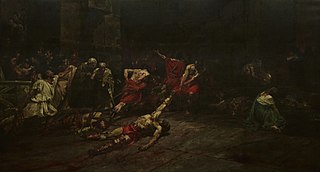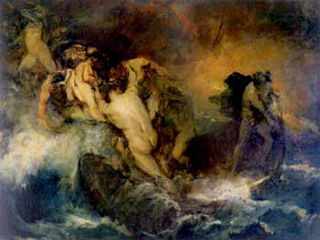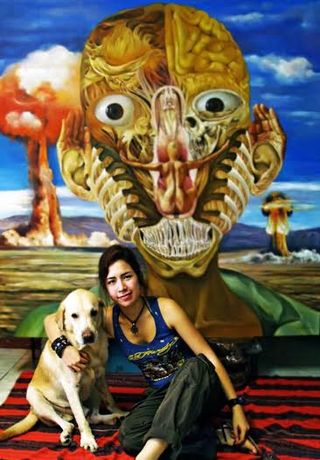Related Research Articles

Rizal, officially the Province of Rizal, is a province in the Philippines located in the Calabarzon region in Luzon. Its capital is the city of Antipolo. It is about 16 kilometers (9.9 mi) east of Manila. The province is named after José Rizal, one of the main national heroes of the Philippines. It is bordered by Metro Manila to the west, Bulacan to the north, Quezon to the east and Laguna to the southeast. The province also lies on the northern shores of Laguna de Bay, the largest lake in the country. Rizal is a mountainous province perched on the western slopes of the southern portion of the Sierra Madre mountain range.

Mandaluyong, officially the City of Mandaluyong, is a first class highly urbanized city in the National Capital Region of the Philippines. According to the 2020 census, it has a population of 425,758 people.
José Tanig Joya was a Filipino abstract artist and a National Artist of the Philippines awardee. Joya was a printmaker, painter, mixed media artist, and former dean of the University of the Philippines' College of Fine Arts. He pioneered abstract expressionism in the Philippines. His canvases were characterized by "dynamic spontaneity" and "quick gestures" in action painting. He is the creator of compositions that were described as "vigorous compositions" of heavy impastoes, bold brushstrokes, controlled dips, and diagonal swipes". Joya added the brilliant tropical colors. He was awarded a grant, which enabled him to pursue a master's degree in Fine Arts in 1956–57. His works were strongly influenced by the tropical landscapes of the Philippine Islands. Among his masterpieces are the jedree (a collage rendered with Asian calligraphy and forms and patterns resembling rice paddies), the Granadean Arabesque (1958) and Biennial (1964)

Juan Luna de San Pedro y Novicio Ancheta was a Filipino painter, sculptor and a political activist of the Philippine Revolution during the late 19th century. He became one of the first recognized Philippine artists.

The Spoliarium is a painting by Filipino painter Juan Luna. Luna, working on canvas, spent eight months completing the painting which depicts dying gladiators. The painting was submitted by Luna to the Exposición Nacional de Bellas Artes in 1884 in Madrid, where it garnered the first gold medal. The picture recreates a despoiling scene in a Roman circus where dead gladiators are stripped of weapons and garments. Together with other works of the Spanish Academy, the Spoliarium was on exhibit in Rome in April 1884.

The legislative districts of Rizal are the representations of the province of Rizal in the various national and local legislatures of the Philippines. At present, the province is represented in the House of Representatives of the Philippines by its four congressional districts, with the districts' representatives being elected every three years. Additionally, each district is allotted a certain number of seats in the Rizal Provincial Board, with board members also being elected every three years.

Ambeth R. Ocampo is a Filipino public historian, academic, cultural administrator, journalist, author, and independent curator. He is best known for his definitive writings about Philippines' national hero José Rizal and on topics on Philippine history and Philippine art through Looking Back, his bi-weekly editorial page column in the Philippine Daily Inquirer.

Mario Parial was a multi-awarded Filipino painter, printmaker, sculptor and photographer. His works have been sold at Sotheby's.

Pablo Cueto Amorsolo was a Filipino painter. He was the younger brother of the Philippine National Artist Fernando Amorsolo.

The Ateneo Art Gallery is a museum of modern art of the Ateneo de Manila University. It is the first of its kind in the Philippines. It serves as an art resource for the university community and the general public as well. The Gallery is located at the Arts Wing, Areté, Ateneo de Manila University, Katipunan Avenue, Loyola Heights, Quezon City.

La barca de Aqueronte, translated in English as The Boat of Charon or Charon's Boat, is an 1887 oil-on-canvas and allegorical painting by the Filipino painter Félix Resurrección Hidalgo. The work was a gold medalist during the Exposicion General de las Filipinas in Madrid. In 1889, an international jury made the painting a silver medalist during the Paris Exposition, a distinct recognition that no other Filipino painter had achieved at the major art arena in Paris. The painting also won other awards such as a diploma of honor from the 1891 Exposicion General de Bellas Artes in Barcelona, a gold medal prize at the 1893 Madrid Exposicion Internacional de Bellas Artes during the 400th Anniversary of the Discovery of the Americas. The Government of Spain bought the work of art through a royal decree for the amount of 7,500 pesetas on March 7, 1893. After displaying the artwork at the Museo-Biblioteca de Ultramar and at the Museo de Arte Moderno., La barca de Aqueronte is currently placed at Madrid’s Museo Nacional de Pintura, after the Philippines became a United States territory in 1898. A smaller study of the same painting in the collection of the Lopez Museum in the Philippines.

Marcel Antonio is a Filipino painter. Considered one of the most promising young talents in Philippine contemporary art while still attending the University of the Philippines' College of Fine Arts in the late 1980s, he launched a solo show and thereafter dropped out of the college to continue to produce collections of his distinctly narrative as well as pseudo-narrative figurative paintings influenced by modernism and 1980s postmodernism. Since then, Antonio produced enough sold-out works to be quickly counted as one of the Philippines' young painters most proficient in the magic realist sort of post-expressionism in the country.
Joy Mallari is a contemporary Filipino painter and visual artist.

Fernando Belen Sena is considered the Father of the Philippine Art Workshop for his tireless efforts in sharing his knowledge and talent with those who wish to learn. An all-around painter, Sena was born in Tondo, Manila and earned a Bachelor of Fine Arts degree majoring in painting from the University of the East in 1971.
Geraldine Javier is a contemporary Filipina Visual Artist whose work is best known for her work which blends of painting with various media, and is "recognized as one of the most celebrated Southeast Asian artists both in the academic world and in the art market."

Camille Jean Verdelaire D. Dela Rosa is a painter who studied at the University of the Philippines, Diliman. Her works, commencing in 1998, include Impressionist gardens, landscapes, churches, beaches, and morbid surrealisms.
Katrina "Keiye" Miranda-Tuazon is a modern art painter from Angono, Rizal. Also known as "Keiye Miranda", daughter of the famous painter, Nemesio Miranda Jr. She was known for her underwater pool themed paintings. She had her first solo exhibition at Surrounded by Water in Angono, Rizal and also had a show in a gallery that her family is managing in SM Megamall at the Nemiranda Arthouse where she first started to do her underwater themed painting. She was inspired to continue her underwater-themed paintings after receiving positive feedback from her family and peers.
Danilo Palomer Santiago is a Full-time Filipino Eclectic painter, professor and Department Chair of University of Santo Tomas - College of Fine Arts and Design (UST-CFAD), Painting Department. His murals are displayed at the Malacaňang Palace, UST Main Building - Faculty of Civil Law and Veterans Memoraila Medical Center and whose works won awards in various art competitions. He was born in Sorsogon, Philippines and now lives in Manila.
Roy Santos Veneracion is a Filipino painter whose work explores a wide range of styles, techniques, materials, and subject matter. He is considered one of the leading abstract artists in the Philippines and the precursor of contemporary Aesthetic Syncretism. His work is associated with the Syncretism art movement in the Philippines and abroad.
Wilfredo Beltran Alicdan is a Filipino figurative artist. His works are distinguished by their quaint and geometric folk representations, populated by rounded stylized figures usually engaged in traditional and rural activities.
References
- 1 2 3 "Philippines, Manila, Civil Registration, 1899-1984 Image Philippines, Manila, Civil Registration, 1899-1984; ark:/61903/3:1:939F-KSSZ-2V — FamilySearch.org". FamilySearch . Retrieved October 31, 2015.
- 1 2 3 4 5 6 7 8 9 10 11 12 13 14 15 16 17 18 19 20 Elmer Borlongan: In City and Country (1992-2012). Makati, Philippines: Ayala Museum. 2014. ISBN 978-971-8551-89-9.
- 1 2 3 4 "Canvas - The Rocking Horse". Canvas.ph. Archived from the original on 2015-03-09. Retrieved 4 January 2015.
- 1 2 3 4 5 6 7 8 "The Importance Of Being Elmer Borlongan". Yahoo News Philippines. 25 June 2012. Retrieved 4 January 2015.
- ↑ "The Importance Of Being Elmer Borlongan". Yahoo News Philippines. 18 June 2012. Retrieved 4 January 2015.
- 1 2 "Kulay-Diwa Gallery of Philippine Contemporary Art - Elmer Borlongan". Kulay-diwa.com. Retrieved 4 January 2015.
- ↑ "THIRTEEN ARTISTS AWARDS CEREMONY AND EXHIBIT OPENING AT THE CCP | Cultural Center of the Philippines". culturalcenter.gov.ph. Archived from the original on 18 July 2013. Retrieved 27 January 2022.
- 1 2 Ito, Lisa (2011). "Bridging the Realities of Elmer Borlongan's Art". Kariyanan. Antipolo, Rizal: Pinto Art Gallery.